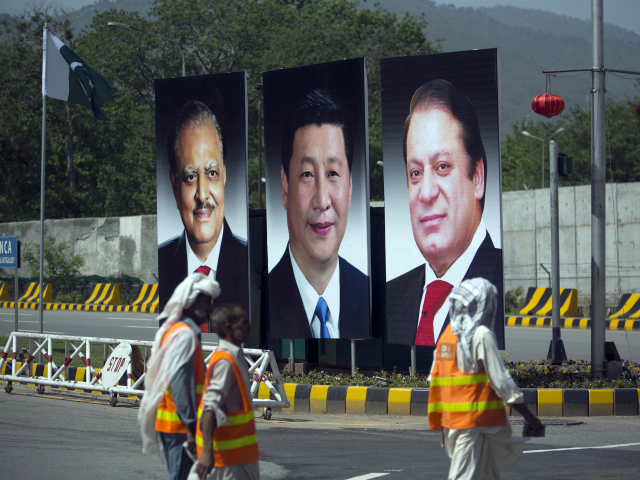This morning’s key headlines from GenerationalDynamics.com
- Pakistan’s Balochistan Liberation Army (BLA) claims credit for killing CPEC workers
- Questions raised about planned China military naval base in Jiwani
Pakistan’s Balochistan Liberation Army (BLA) claims credit for killing CPEC workers

Gwadar Port
The separatist terror group Balochistan Liberation Army (BLA) claimed credit for killing on October 31 five men working for a construction company building 70 housing developments. The housing will be populated by thousands of Chinese workers who will be working on the China-Pakistan Economic Corridor (CPEC). The housing developments are on the road connecting Gwadar port to the town of Jiwani.
According to Azad Baloch, a BLA spokesman:
The site attacked today was part of the CPEC project.
…
Today’s attack is a clear message to China and all other countries that Balochistan is an occupied territory. We warn China to halt working on all the projects including a planned naval base in Jiwani, Balochistan. The BLA will continue to resist against the occupation of Baloch Ocean and coastal belt.
…
China and Pakistan are settling Punjabis and Chinese in Gwadar and other areas of Balochistan’s coastal belt to turn the Baloch into a minority under their expansionist designs.
If the international community fails to fulfil their responsibilities and turn a blind eye to the Pakistani and Chinese colonization of Balochistan, then the Baloch nation will have no other option but to target all non-Baloch settlers in Balochistan.
This was only the latest in a series of BLA attacks on CPEC targets in Balochistan. On October 26, the BLA conducted a joint operation with another separatist group, the Baloch Liberation Front (BLF), and killed two Pakistani paramilitary soldiers in a coordinated attack on a senior officer’s convoy. In September, there were seven terrorist attacks in Balochistan. In August, the BLA claimed credit for a suicide bombing attack on a bus transporting Chinese workers, injuring three.
After the August suicide bombing, Chinese companies hired more security personnel to protect Chinese workers. However, the targets of the most recent terror attacks were not Chinese, and not Baloch. Furthermore, they were not killed with a suicide bombing. Instead, they were killed when unidentified motorcyclists opened fire at them and fled. Also, they were from other provinces in Pakistan. The BLA is insisting that with unemployment and poverty so high among Baloch people, Baloch workers should be doing the CPEC development, rather Chinese workers or workers from Punjab.
A Chinese investment firm has already announced a project to build homes for 500,000 Chinese professionals in Gwadar by 2023. Dawn and South Asia Terrorism Portal (SATP – India) and Al Jazeera and Express Tribune (Pakistan, 11-Oct) and The News (Pakistan, 21-Oct-2017)
Questions raised about planned China military naval base in Jiwani
CPEC is a $55-60 billion 20-year project that will supposedly build a network of roads, railways, and energy pipelines aiming to connect western Chinese cities, starting from China’s easternmost city Kashgar in Xinjiang province, to the seaport in Gwadar on the Indian Ocean in Balochistan province in southern Pakistan. Power generation, transport, commerce, R&D, and the defense of Pakistan all will be increasingly tied to Chinese investment, supplies, and interests.
China has always insisted that Gwadar will be a purely commercial port, with no military purpose at all. As usual, we seem to be facing deception, double-talk, and lying from the Chinese.
Recall that in 2015, China’s Communist Party leader Xi Jinping said his country had “no intention to militarize” the South China Sea, and that they would be tourist attractions. It was just as much a lie as when Hitler promised “peace in our time” as he was planning to invade Britain. Today, the Chinese military has turned them into bases, bristling with radar domes, shelters for missiles, warplane runways, and other heavy military equipment. No tourists are welcome.
In January of this year, there were reports that Gwadar would become a Chinese military naval base. China denied the report, but an article in the South China Morning Post reported that the military base would not be in Gwadar itself, but nearby on the Jiwani Peninsula. The article quoted a Beijing-based military analyst who said:
China needs to set up another base in Gwadar for its warships because Gwadar is now a civilian port.
It’s a common practice to have separate facilities for warships and merchant vessels because of their different operations. Merchant ships need a bigger port with a lot of space for warehouses and containers, but warships need a full range of maintenance and logistical support services.
At a Beijing forum last week, Javaid Iqbal, Secretary of the Pakistan Navy, was asked whether Gwadar is the location of a future Chinese military base. He evaded the question by restricting his answer to Gwadar port: “Let me emphasize that the Gwadar port is purely a commercial venture and has no military overtones. The Gwadar port has no military dimension. It will be just a commercial port.” So, no mention of a base in nearby Jiwani. Aren’t these people wonderful? Diplomat (9-Feb) and South China Morning Post (Hong Kong, 5-Jan) and Reuters (26-Oct) and Asia Maritime Transparency Initiative (CSIS/AMTI)
Related Articles:
- Chinese workers in Pakistan injured in terrorist bombing (15-Aug-2018)
- Pakistan faces imminent financial crisis threatening China’s CPEC (07-Aug-2018)
- Pakistan overwhelmed and China alarmed over the China-Pakistan Economic Corridor (CPEC) (12-Dec-2017)
- Execution of two of China’s citizens in Pakistan raises concerns about CPEC (10-Jun-2017)
- Terror attack in Quetta, Balochistan, Pakistan, kills 75 (09-Aug-2016)
KEYS: Generational Dynamics, Pakistan, Balochistan, China, Balochistan Liberation Army, BLA, Baloch Liberation Front, BLF, China-Pakistan Economic Corridor, CPEC, Kashgar, Xinjiang, Gwadar seaport, Jiwani, Javaid Iqbal
Permanent web link to this article
Receive daily World View columns by e-mail

COMMENTS
Please let us know if you're having issues with commenting.